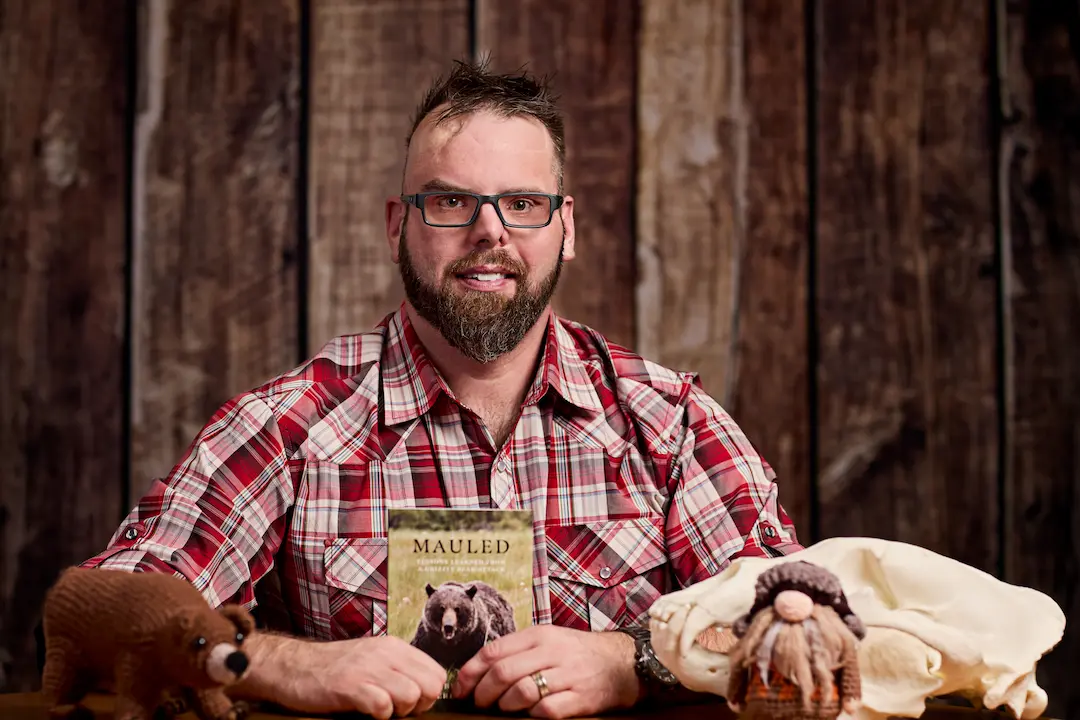In the rugged wilderness of Alberta, where mountains touch the sky and grizzly bears roam free, Jeremy Evans found both his greatest passion and his darkest nightmare. Known today as “The Grizzly Dude,” Evans has transformed a horrific bear attack that nearly claimed his life into a powerful message of human resilience. His journey from victim to victor offers lessons that resonate far beyond the wilderness, inspiring individuals facing their own personal battles to find strength they never knew they possessed.
MOUNTAIN ROOTS: THE MAKING OF AN OUTDOORSMAN
Growing up in Calgary, Alberta—just a short drive from the Canadian Rockies—Evans developed an early fascination with the mountains. “They seemed like they touched the sky,” he recalls, his eyes lighting up with the same wonder he felt as a child. “I just wanted to climb them.” This childhood wonder evolved into a lifelong passion that would shape his identity and ultimately test his will to survive.
When he got his first car, Evans spent every possible moment in the mountains—hiking remote trails, fishing crystal-clear streams, and exploring untamed wilderness. The mountains became his sanctuary, a place where the complexities of modern life faded against the backdrop of natural grandeur.
For Evans, nature transcends mere recreation. “Nature is more than just a place to visit—it is where I feel most alive,” he explains. “The mountains, rivers, and forests have taught me resilience, patience, and humility.” These natural spaces became classrooms that shaped his character, teaching him to find “strength in adversity and peace in solitude.”
This profound connection to the outdoors extended naturally to his family life. Whether traversing challenging mountain trails or gathering around a crackling campfire under star-filled skies, these shared experiences in nature created what Evans calls “a space for genuine connection, free from distractions.” The wilderness provided opportunities for his family to learn “valuable lessons about teamwork, perseverance, and appreciating the simple things”—lessons that would later prove invaluable during his darkest hours.
Little did Evans know that the wilderness he loved would soon test his resilience in ways he could never have imagined, transforming not only his body but his entire perspective on life.
AUGUST 24, 2017: THE DAY EVERYTHING CHANGED
What began as a routine sheep hunting trip in the predawn hours of August 24, 2017, quickly became a fight for survival that would forever alter Evans’ life. After a three-hour drive to his chosen spot, Evans wasted no time hitting the trail, excited about the day ahead.
Crossing two deep drainages and following a narrow game trail through thick bush, Evans eventually spotted some sheep across a valley. Raising his binoculars, he watched them closely, resting his elbows on his bike handlebars to steady his arms. When he stood to stretch, Evans caught a glimpse of something small and brown darting in front of him—a grizzly cub. In that moment, he knew he was in serious danger.
“Where there’s a cub, there’s a mother,” Evans recounts, his voice steady despite the gravity of the memory.
As he reached for his bear spray, Evans heard a sharp crack—a branch snapping over his right shoulder. Within seconds, the mother bear was upon him—an arm’s length away, teeth visible, eyes locked on him. What followed was a brutal attack that defies imagination.
“I grabbed my bike and threw it in front of me,” Evans recalls. When the bear’s head crashed through the frame, Evans seized the momentary advantage, swinging his backpack into her face. The bear recovered quickly, biting down on his right hand and crushing it against the frame of his pack. “I saw her teeth sink in, felt the bones separate, and heard the grinding against the pack’s frame.”
Somehow, Evans managed to free his hand and continued fighting back. When the bear charged again, Evans scrambled up the mountainside and leaped into a tree—but his refuge proved temporary. Standing on her hind legs, the bear wrapped her front paws around Evans’ right leg and yanked him downward, her teeth sinking into his leg behind the knee.
“She peeled me out of that tree like I weighed nothing,” Evans says.
On the ground, Evans scrambled under a thick spruce tree, wrapping his arms and legs around its base. But the bear reached in, biting into his left side above the hip. She picked him up and shook him “like a rag doll” before tossing him aside with such force it knocked the wind from his lungs.
Before he could even catch his breath, the bear was on him again—this time clamping her jaws around the left side of his face. “I heard the bones crack and pop,” Evans remembers. “It sounded like ice breaking.”
In a moment of remarkable clarity amid unimaginable pain, Evans thought, “This really sucks… getting chewed on while playing dead.” Instinct took over. He rolled onto his back and fought with everything he had, punching the bear’s face and poking her eye. When the bear prepared for another attack, Evans instinctively shoved his hand into her mouth, grabbing her tongue.
Through extraordinary determination and some desperate defensive maneuvers, Evans twice managed to drive the bear away. Left with catastrophic injuries—his face partially torn away, his scalp in pieces, ligaments severed—Evans faced a moment of despair so profound he contemplated ending his suffering.
Yet something pulled him back from the brink. “I owed it to my family to keep going,” he says. In that moment of clarity, the memory of his eight-month-old daughter saved him. As “Baby Shark”—the same song he had played while putting his daughter to sleep the night before—came through his phone’s speakers, Evans found renewed determination.
Unable to walk due to his severed knee ligaments, Evans began the arduous journey to safety—crawling inch by inch, one painful movement at a time. “I reached for the first rock,” he recalls, “and pulled myself forward.”
Hours later, after an incredible testament to human endurance, Evans reached a nearby lodge. The first person to see him wasn’t a first responder or medical professional—it was a nine-year-old boy sitting by a window, who would later give Evans the nickname that would define his new purpose.
BEYOND SURVIVAL: THE JOURNEY TO RECOVERY
Surviving the attack was just the beginning of Evans’ battle. The physical recovery included multiple surgeries to reconstruct his face and body, months of grueling rehabilitation, and persistent pain that would become a constant companion. “But the mental battle was even tougher,” Evans admits. “The fear, the nightmares, and the moments of doubt were relentless.”
Evans doesn’t shy away from discussing the depth of his psychological trauma. PTSD manifested in flashbacks that could be triggered without warning, robbing him of sleep and peace of mind. He sought psychiatric help and discovered that healing often requires multiple approaches tailored to individual needs. “The mental side took years to heal, and even now, some challenges remain,” he acknowledges.
Five years after the attack, Evans experienced a breakthrough with Accelerated Resolution Therapy (ART), which finally allowed him to “sleep soundly for the first time since the attack.” This experience highlighted the critical importance of finding the right treatment approach for trauma survivors—a mission that would later inspire his foundation.
Throughout his recovery, Evans set small, achievable goals and reminded himself daily that he was more than his trauma. “I focused on what I could do today, not everything that still needed to be done,” he explains. This methodical approach to healing—focusing on incremental progress rather than the enormity of recovery—became a cornerstone of his resilience philosophy.
The scars on Evans’ body—visible reminders of his encounter—became not symbols of victimhood but badges of survival. “Physically, there are still lasting effects,” he notes. “I have no feeling in certain areas, and some things just don’t work the same.” Yet these limitations never defined his recovery or his future potential.
THE BIRTH OF “THE GRIZZLY DUDE”
The nickname “The Grizzly Dude” came from an unexpected source—that nine-year-old boy who first spotted Evans stumbling toward safety after the attack. “That moment is burned into my memory,” Evans recalls. “It was the first sign that I had made it to safety.”
What began as a child’s impromptu label eventually evolved into something much more significant. “At first, it was just a nickname—kind of funny, almost like something out of a Spider-Man origin story,” Evans explains. “I didn’t think much of it at the time.” But as he recovered and began sharing his story, the moniker stuck.
When preparing to release his book, *Mauled: Lessons Learned from a Grizzly Bear Attack*, Evans created a Grizzly Dude logo to help promote it. “I used it as a virtual background at work, just for fun,” he says. This casual beginning quickly transformed into something much bigger—T-shirts, hats, and his signature slogan: “You can BEAR it—even when you think you can’t.”
“Before I knew it,” Evans reflects, “Grizzly Dude had become more than a nickname. It became a symbol—of resilience, of courage, of the indomitable human spirit.” Today, Grizzly Dude represents more than just Evans’ survival story—it embodies his message of resilience to the world and has become both his brand and his mission.
The transformation from victim to symbol of strength wasn’t planned, but it provided Evans with a platform to share his experiences and the lessons he learned. Through this unexpected identity, he found purpose in his suffering—a way to transform personal trauma into universal wisdom.
PICKING UP THE PIECES: LESSONS IN RESILIENCE
Evans’ signature keynote presentation, “Picking Up the Pieces,” centers on a powerful metaphor: life after trauma is like a shattered puzzle that can never be reassembled in its original form.
“For a long time, I tried to force the pieces of my old life back together, but they never fit,” Evans reflects. “Eventually, I realized I didn’t need to rebuild what was lost—I needed to create something even stronger.”
This perspective offers wisdom beyond survival stories. For entrepreneurs facing business failures, professionals navigating career setbacks, or individuals confronting personal crises, Evans’ message remains consistent: true resilience isn’t about restoring what was, but building something new from the fragments.
“This lesson isn’t just about survival,” Evans explains. “It applies to business, leadership, and personal growth. Entrepreneurs, professionals, and individuals all face setbacks that completely alter their trajectory. The key isn’t to cling to what was—it’s to embrace what can be.”
Evans advocates finding your “rock”—the foundation that anchors you when everything else feels unstable. “Whether it’s in survival or business, you need something to anchor you when everything else feels like it’s falling apart,” he advises. “For entrepreneurs, that rock might be a mentor, a support system, or the original vision that inspired them to start.”
Perhaps most importantly, Evans emphasizes that resilience doesn’t mean recovering alone. “Picking up the pieces doesn’t mean doing it alone,” he insists. “Just like in survival, the strongest people in business and life are the ones who seek out experts, lean on their team, and surround themselves with the right people.”
THE POWER OF DETERMINATION
If there’s one lesson from Evans’ experience that resonates most with audiences, it’s this: “Human determination can defy the greatest of odds.”
The attack and immediate survival represent just one chapter in Evans’ story. The real battle came during recovery, when pain, fear, and uncertainty threatened to overwhelm him. “Determination isn’t about never struggling,” Evans emphasizes. “It’s about choosing to take the next step, no matter how difficult.”
This message connects with people facing diverse challenges. Whether physical injuries, emotional trauma, or professional setbacks, Evans’ experience demonstrates that resilience isn’t avoiding adversity but confronting it directly.
“Surviving the attack was just the beginning—the real battle was in the recovery,” he explains. “There were moments when the pain, fear, and uncertainty felt insurmountable, but I refused to give up.” This determination manifested in small victories that accumulated over time—first movements, first steps, first public appearances after the attack.
Evans’ story provides living proof that human willpower can overcome seemingly impossible obstacles. “Resilience isn’t about avoiding hardship,” he says. “It’s about facing it, adapting, and pushing forward. One step at a time.”
VULNERABILITY AND HUMOR: AN UNEXPECTED COMBINATION
In his speaking engagements, Evans employs an unconventional pairing: raw vulnerability alongside carefully placed humor. This approach serves a strategic purpose in connecting with audiences facing their own challenges.
“Vulnerability makes my message authentic,” Evans explains. “I don’t sugarcoat the struggle; I talk openly about the pain, the fear, and the doubts I faced after the attack.” By revealing his lowest moments—including his contemplation of suicide during the immediate aftermath—Evans creates space for others to acknowledge their own struggles.
“When I share my lowest moments, it gives others permission to acknowledge their own struggles and see that resilience isn’t about being fearless—it’s about pushing forward despite the fear,” he says.
Equally important is humor, which Evans uses to balance the intensity of his story. “Let’s be real—talking about getting mauled by a grizzly bear can get pretty heavy,” he admits with a characteristic smile. “A well-placed joke not only lightens the mood but also reminds people that even in the darkest moments, laughter is still possible.”
Evans recalls moments during his recovery when humor provided essential relief from the gravity of his situation. “It’s part of how I coped with my recovery, and it shows that no matter what we face, we can still find joy.”
This combination of transparency and levity transforms Evans’ survival story into something universally applicable. As he puts it, “At the end of the day, we all face our own ‘grizzly bears.’” Through vulnerability, audiences see themselves in his struggle; through humor, they find the courage to confront their own challenges.
ADVOCATING FOR MENTAL HEALTH
Evans’ recovery journey revealed the critical importance of mental health support. His experience with post-traumatic stress disorder (PTSD) highlighted both the challenges of finding effective treatment and the transformative power of appropriate care.
“I faced years of physical and psychological recovery, including battling PTSD,” Evans shares. “I struggled with flashbacks, sleepless nights, and tried various forms of therapy.” The search for effective treatment proved almost as challenging as the physical recovery, with multiple approaches yielding limited results.
Five years after the attack, Evans experienced a breakthrough with Accelerated Resolution Therapy (ART), which allowed him to “sleep soundly for the first time since the attack.” This personal experience inspired him to establish The Grizzly Dude Fund, dedicated to advancing PTSD research and improving mental health support systems.
The fund aims to develop best practices for matching evidence-based PTSD treatments with those who need them and help survivors navigate the often confusing landscape of mental health resources. “If the minimum goal is not met by June 30, 2025,” Evans notes, “the funds will be redirected to create a scholarship supporting students in mental health-related fields.”
For Evans, mental health advocacy extends beyond his personal foundation. He emphasizes that seeking help is “not a sign of weakness—it’s a sign of strength.” This message resonates particularly in high-stress environments, where stigma often prevents individuals from accessing necessary support.
“Too often, people in high-pressure roles feel like they have to ‘tough it out’ alone,” Evans observes, “but that mindset only leads to burnout and deeper struggles.” His advocacy focuses on normalizing conversations about mental health and ensuring that support resources are not just available but actively encouraged.
DIFFERENT AUDIENCES, UNIVERSAL MESSAGE
Evans’ speaking engagements reach diverse audiences, from first responders facing life-threatening situations to corporate teams navigating business challenges. While these groups encounter different types of adversity, Evans observes fundamental similarities in their needs for resilience and support.
“First responders are trained for crisis—they thrive under pressure, react quickly, and push through extreme situations,” Evans explains. “But that same training can make them suppress their personal struggles, leading to long-term emotional and mental exhaustion. Many are taught to ‘just deal with it’ rather than process their experiences in a healthy way.”
Corporate teams, meanwhile, face “a different kind of stress—less immediate danger, but constant pressure, deadlines, and the weight of long-term burnout. Instead of life-or-death moments, they deal with ongoing high expectations and responsibilities that can feel overwhelming.”
For both groups, Evans emphasizes similar principles: acknowledge the weight you carry rather than ignoring stress; break challenges into manageable steps to prevent overwhelm; and seek support not just for professional demands but for personal wellbeing.
“By embracing adaptability, processing stress in healthy ways, and supporting each other,” Evans advises, “both first responders and corporate teams can strengthen their resilience—not just for their work, but for life.”
EMBRACING LIFE’S SIMPLE JOYS
Despite—or perhaps because of—his harrowing experience, Evans finds profound appreciation in life’s quiet moments. “Some of the greatest joys in my life now are the simple, everyday moments—the ones that remind me just how precious life truly is,” he shares.
These include mornings by the river, watching the water flow with meditative calm. Family hikes with no particular destination, where the journey itself becomes the reward. Teaching his daughter to ice skate or his son to ride a bike—developmental milestones that many parents might take for granted.
Evans even finds joy in the mundane daily ritual of checking eggs from their flock of ducks and chickens. “The real competition isn’t just about collecting eggs,” he says with a smile, “it’s about who can find the most.”
“After everything I’ve been through,” Evans reflects, “I’ve learned that happiness isn’t found in the big, extraordinary things—it’s in the simple joys we often take for granted.” This perspective—finding meaning in seemingly ordinary moments—represents perhaps the most profound transformation in Evans’ outlook following his brush with death.
LOOKING FORWARD: THE EXPANDING MISSION
Evans continues to expand his reach through various initiatives designed to share his message of resilience with wider audiences. Beyond The Grizzly Dude Fund, he’s working to bring his message to more diverse groups through speaking engagements, digital content, and partnerships with mental health organizations.
He’s also exploring a second book focused specifically on mental resilience and practical strategies for overcoming trauma. Unlike his first book, which chronicled his survival story, this project aims to provide “a practical, hands-on guide for those seeking inspiration and actionable strategies” for building resilience in their own lives.
Evans plans to expand his online presence through social media, video content, and online workshops, providing “bite-sized lessons on resilience, mental health, and personal growth.” This digital expansion aims to make his message accessible to people wherever they are, whenever they need it.
Throughout these diverse initiatives, Evans’ core mission remains constant: “To remind people that no matter how tough the climb, they have the strength to take the next step.”
THE LASTING LEGACY OF THE GRIZZLY DUDE
When asked about the legacy he hopes to leave, Evans’ answer is characteristically straightforward: “I want people to remember that no matter how dark the road gets, they have the strength to keep going.”
His story transcends mere survival. It’s about “choosing to live fully, despite the scars.” It’s about finding purpose within suffering and refusing to be defined by trauma. If Evans can inspire even one person to persevere when surrender seems inevitable, he considers his mission accomplished.
“I hope my legacy is one of strength, perseverance, and hope,” Evans reflects. “That people will remember not just the challenges I faced, but the lessons I shared—that fear isn’t the enemy, that asking for help is a sign of strength, and that even after life knocks you down, you can stand up stronger than before.”
In the world of motivational speaking, many share messages of resilience and determination. What distinguishes Evans is the visceral authenticity of his experience and the humble wisdom with which he shares it. He doesn’t present himself as superhuman or exceptional—instead, he emphasizes that the same strength he found exists within everyone facing their own challenges.
In the end, Jeremy “The Grizzly Dude” Evans offers perhaps the most succinct expression of resilience possible: “You can BEAR it—even when you think you can’t.” It’s a message that resonates not because it promises easy solutions, but because it acknowledges the reality of suffering while affirming the human capacity to endure and ultimately thrive.
To book Jeremy Evans as a speaker, visit www.grizzlydude.ca or follow his journey on Instagram: @TheGrizzlyDude1





